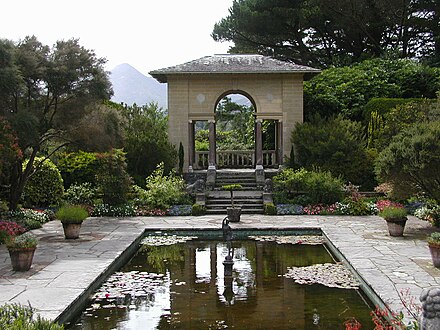Southwest Ireland - NUTS Level III region of Ireland and is governed by the South-West Regional Authority
Southwest Ireland is a region of Ireland comprising County Cork and County Kerry. With a population of 689,750 in 2016, it's one of the eight regions of Ireland for statistical and planning purposes, and more snappily known as "IE053 - NUTS Level III"; it's not a unit of local government. Historically it's part of the kingdom or province of Munster, which occupied the southwest quarter of Ireland.
Counties
This has Ireland's second-largest city and green plains to the north. The intricate coast becomes rugged west of Kinsale, and ever-wilder as you head onto the Atlantic peninsulas.
Kerry reverses that trend, with its wave-dashed peninsulas to the south and scattered islands. The terrain quietens down through Tralee to the Shannon estuary.
{{mapshape|type=geoshape|fill=|title=County Cork|wikidata=Q162475}} {{mapshape|type=geoshape|fill=|title=County Kerry|wikidata=Q184469}}
Towns
- Cork is the region's large and lively city, with lots to see and do, and nearby historic Blarney and Cobh.
- Mallow exemplifies lowland Cork, with the race-track and castle ruins.
- Kinsale has two forts guarding its historic harbour; it's the south end of the Wild Atlantic Way.
- Bantry is a good base for all three of Cork's main peninsulas.
- Tralee the county town of Kerry has a well-preserved 19th century centre.
- Killarney is a very scenic place, with the lakeside castle and mountains rearing up beyond.
- Portmagee is the usual starting point for boats to Skellig Michael.
Other destinations
- Dingle Peninsula is the most northern of this region's five major peninsulas. Its chain of mountains culminate in Mount Brandon, near the main village of Dingle.
- Ring of Kerry is the name given to the 214 km circuit of Iveragh Peninsula. Trips usually start from Killarney.
- Skellig Michael is the most remarkable but the hardest to reach of the region's many islands. A medieval monastic complex teeters on its twin peaks, 12 km out in the Atlantic.
Understand
.jpg/440px-Cobh_Ireland_(14609348177).jpg) Great tides of influx and emigration have marked this region - and they literally were tides for the earliest settlers landing in small coves and creeks to populate the lowlands. Celtic tribes coalesced into petty kingdoms then into the entity of Munster. Vikings and Normans staked their claims but didn't get much beyond Cork before being repulsed, so it was only in Tudor times that England took a grip. Munster in the 12th century had fractured into a north and south kingdom: Deasmhumhain or South Munster, hence "Desmond", resisted long and hard until subdued in the 16th century. It only remained to divvy up the best of the land to loyal English nobles, which was how Sir Walter Raleigh came to be mayor and landowner in the east of County Cork through into Waterford.
Great tides of influx and emigration have marked this region - and they literally were tides for the earliest settlers landing in small coves and creeks to populate the lowlands. Celtic tribes coalesced into petty kingdoms then into the entity of Munster. Vikings and Normans staked their claims but didn't get much beyond Cork before being repulsed, so it was only in Tudor times that England took a grip. Munster in the 12th century had fractured into a north and south kingdom: Deasmhumhain or South Munster, hence "Desmond", resisted long and hard until subdued in the 16th century. It only remained to divvy up the best of the land to loyal English nobles, which was how Sir Walter Raleigh came to be mayor and landowner in the east of County Cork through into Waterford.
The rugged southwest was ignored: by boat you could get around it or go fishing but inland had poor farming and no mineral resources, all it was good for was breaking your cart axles. It had a precarious, subsistence way of life even in the good years, so the famine years struck very hard. Those who could, fled. Population outflow continued even after the famine, as much by "pull" of the British and North American city economies as by the "push" of poverty. It was for those emigrants that Titanic called at Cobh westbound.
What brought people back was tourism. This was attempted as early as 1750, but it only took off in the 19th century with the arrival of the railways, the growth of a middle class with time and income for leisure, and the Romantic movement which re-painted a barren, stony landscape as fine scenery. Postcards, railway posters and tea-towels publicised the area, and the Irish diaspora became its ambassadors. Cork, Blarney Castle, Killarney and its lakes, and the Ring of Kerry, all became established on the tourist circuit, and they still are.
Get in
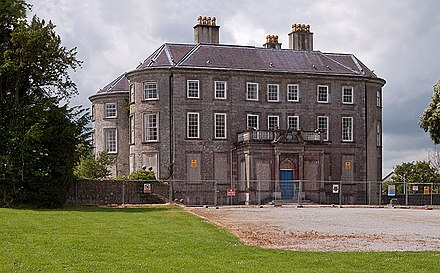
By plane
Shannon Airport 📍 (IATA: SNN) north across the Shannon estuary is a major portal of entry into Ireland. It has many flights from Europe, UK and the United States, with US border pre-clearance, and in summer from Toronto. The largest operators are Ryanair and Aer Lingus. There are several car rental agencies.
Kerry Airport 📍 (IATA: KIR) is midway between Tralee and Killarney. It has daily flights from Dublin, and year-round from London Stansted and Luton, Manchester, Frankfurt-Hahn, plus seasonal Med destinations.
Cork Airport 📍 (IATA: ORK) has a range of flights from the UK and Europe but is too small for transatlantic traffic.
Dublin Airport (IATA: DUB) is often a good option because of its wide range of flights and competitive fares, compensating for the extra drive.
By train
Trains run hourly from Dublin Heuston, taking 2 hr 40 min to Cork via Kildare, Portlaoise, Ballybrophy, Thurles, Limerick Junction (for Tipperary or Limerick) and Mallow. A branch-line from Mallow connects to Killarney, Farranfore (for Kerry Airport) and Tralee.
By bus
Buses run hourly from Dublin Airport and Busáras to Cork, with three operators competing on the route.
Dublin Coach M7 runs hourly from Dublin city via Limerick, Adare, Newcastle West and Abbeyfeale to Killarney and Tralee.
City Link runs every 3 hours from Galway via Shannon Airport and Limerick to Cork city centre and airport. The slower Bus Éireann 51 runs hourly from Galway via Ennis, Shannon Airport, Limerick and Mallow to Cork.
Expressway Bus 40 runs hourly from Rosslare harbour (for ferries from Wales and the Continent) via Wexford, New Ross, Waterford, Dungarvan and Youghal to Cork, where it takes a break then continues west to Macroom, Ballyvourney, Killarney, Farranfore and Tralee.
Get around
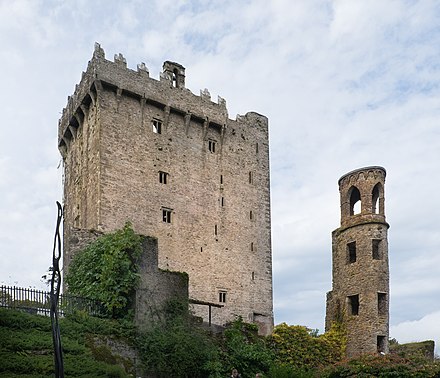
By train
Commuter trains fan out from Cork to Fota (for the wildlife park) and Cobh, to Midleton (for Jameson Distillery) and to Mallow (for Cork racecourse).
There's usually one direct daily train from Cork to Killarney and Tralee, otherwise change at Mallow for the branchline service.
By bus
See above for the inter-city routes from Dublin airport and city, Limerick, and Wexford / Waterford. Expressway Bus 40 trundles right across Ireland, and within this region links Youghal, Cork, Macroom, Killarney and Tralee. Other services from Cork are Bus 251 for Blarney, 220X for Crosshaven, 226 for Kinsale, 237 for Clonakilty, Skibbereen, Baltimore and Schull, and 236 for Bantry, Glengarriff and Castletownbere. Cork also has an extensive urban network.
Killarney has buses to Kenmare and to Tralee, which in turn has buses to Dingle, Listowel and Ballybunion.
That leaves some major gaps, the most gaping being between the Kerry and Cork coasts. A bus runs between Glengarriff and Kenmare in summer but there's no other connection over the hills between them - it doesn't help that the tunnel on the main road is too small for HGVs and coaches. So to bus from Killarney to Bantry normally means backtracking all the way to Cork city. There is likewise no service that circles the Ring of Kerry or its offshoot Ballinskellig Ring. If you want to explore these areas and don't have your own wheels, best join a coach tour - these run from Cork, Killarney and even Dublin.
See individual towns for details of local buses. Away from the radial main roads these are sparse, sometimes only one day a week. For instance the bus from Tralee along the north Dingle peninsula to Castlegregory and Cloghane only runs on Friday, and there's no onward transport to Dingle on the tip.
By road
Most visitors bring their own car. The airports are better for car hire than the towns, but have small fleets so you should pre-book.
See
- Cork highlights include St Fin Barre's Cathedral, Shandon bells, the public museum, Fota wildlife park and Barryscourt Castle.
- Youghal is an old walled port at the east edge of County Cork where Sir Walter Raleigh was once mayor.
- Glengarriff is the unlikely spot for Italianate gardens, reached by a short boat ride.
- Killarney is the tourist capital of Kerry. It's got the lot: a well-repaired castle by the lake, an atmospherically shabby abbey, grand gardens and a museum of country life, Ogham stones inscribed with runes, and Ireland's highest mountains rearing up to the west.
- Prehistoric sites are clustered near Dingle. Ardfert near Tralee is an extensive early Christian site, but the most remarkable is isolated Skellig Michael.
Do
- Boat trips: Fungie the dolphin is no more, but he sparked wildlife tourism in this region. Dolphins, porpoises, orcas and basking sharks patrol the coasts.
- Kiss the Blarney Stone, or to be historically faithful, just invent a whopper about doing so.
- Go to the races at Mallow, Listowel or Killarney.
- Hike: Mount Brandon above Dingle is one of many scenic ascents, the culmination of an ancient pilgrim trail.
- The Wild Atlantic Way is a long-distance motoring and cycling route along the entire western seaboard of Ireland. See county and city pages for more detail, but basically if you follow the coast you're on the right track.
Eat
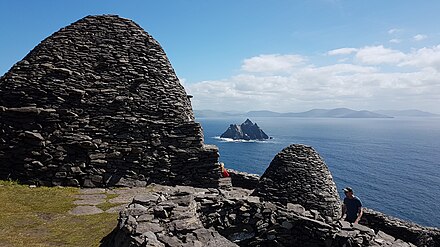
- Cork has the widest selection. The best of the rest of County Cork are Max's in Kinsale, An Súgán in Clonakilty, Customs House in Baltimore, O'Connors in Bantry, Breen's in Castletownbere and Ballymaloe House near Midleton.
- Kerry eating is often pub meals, but Killorglin has two good restaurants, Bianconi's and Jack's.
- Catch it if you can: Cable & Co is a shocking pink food truck on Valentia Island.
- Mulcahy's and Lime Tree in Kenmare get great reviews.
Drink
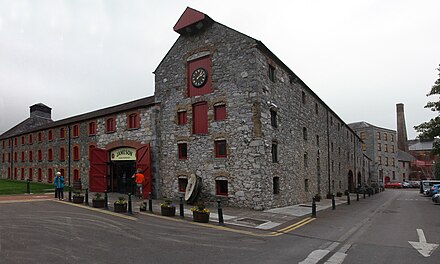
- Lots of village pubs in County Kerry, the most unusual being "The South Pole" in Annascaul, founded by the Antarctic explorer Tom Crean.
- Kerry has breweries in Killarney, Kenmare, Portmagee, and Ballyferriter near Dingle. There are distilleries in Dingle and Caherciveen, and one a-building in Portmagee.
- Cork city has a wide selection of pubs. Moby Dick's pub in Youghal was used as a base and location in the 1956 film Moby Dick.
- The best known distillery in County Cork is Jameson's in Midleton. Others are in Kinsale, Skibbereen and Cape Clear Island off Baltimore.
Stay safe
Natural hazards are the wild Atlantic, large lakes, and mountains where the mist or sleet can suddenly descend upon you.
But the biggest hazards are man-made, so always beware traffic, safeguard valuables and steer clear of louts.
Go next
- County Clare north across the Shannon has old castles and abbeys inland, cliffs along its coast, and the sparse haunting Burren uplands.
- Limerick city is a lively miniature Dublin, with lots of sights and visitor amenities.
- County Limerick is often overlooked, but there's picturesque Adare, a flying boat museum at Foynes, and a prehistoric complex at Lough Gur.
- County Waterford is lush lowland country, with a fine castle at Lismore, and the rich heritage of Waterford, Ireland's oldest city.
South-West Region, Ireland
Timezone:MultipleCoordinates:52.06, -9.06
